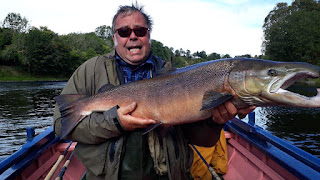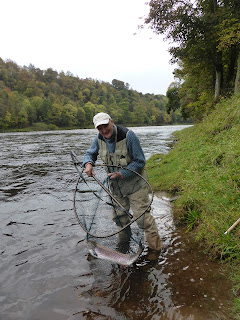The Tay, Perthshire is now in the later part of September for salmon fishing with encouraging results in recent weeksdue some rain and cooler weather conditions as we welcome autumn. In recent weeks the weather pattern has changed giving us far more rain to freshen the river up and dropping the river temperature to produce some better sport. The current conditions have improved dramatically giving everyone a great chance of landing a salmon from the Tay in a difficult year and even possibly a fish of a lifetime with some of the multi sea winter fish currently being caught this season.
Beat catches reported
(week ending 22nd September)
SALMON & GRILSE: Almondmouth 26, Waulkmill 14, Lower Redgorton 12, Luncarty 8, Upper Redgorton 2, Fishponds 6, Benchil 3, Upper Scone 11, Stobhall 20, Taymount 15, Ballathie 20, Cargill 33, Islamouth 11, Meikleour and Upper Islamouth 17, Kercock 6, Delvine Burnbane 1, Glendelvine 3, Newtyle 3, Dunkeld House 3, Dalmarnock 2, Dalguise 4, Lower Kinnaird 6, Upper Kinnaird 1, Findynate 1, Farleyer Lower 1, Loch Faskally 1.
Total: 230 Largest: Lower Redgorton 28lbs
SEA TROUT: Waulkmill 5, Lower Redgorton 3, Upper Redgorton 2, Stobhall 1, Cargill 7, Meikleour and Upper Islamouth 5, Delvine Burnbane 1, Glendelvine 1, Newtyle 1, Lower Kinnaird 2, Loch Faskally 1.
Total: 29 Largest: Lower Kinnaird 5lbs
SALMON & GRILSE: Almondmouth 26, Waulkmill 14, Lower Redgorton 12, Luncarty 8, Upper Redgorton 2, Fishponds 6, Benchil 3, Upper Scone 11, Stobhall 20, Taymount 15, Ballathie 20, Cargill 33, Islamouth 11, Meikleour and Upper Islamouth 17, Kercock 6, Delvine Burnbane 1, Glendelvine 3, Newtyle 3, Dunkeld House 3, Dalmarnock 2, Dalguise 4, Lower Kinnaird 6, Upper Kinnaird 1, Findynate 1, Farleyer Lower 1, Loch Faskally 1.
Total: 230 Largest: Lower Redgorton 28lbs
SEA TROUT: Waulkmill 5, Lower Redgorton 3, Upper Redgorton 2, Stobhall 1, Cargill 7, Meikleour and Upper Islamouth 5, Delvine Burnbane 1, Glendelvine 1, Newtyle 1, Lower Kinnaird 2, Loch Faskally 1.
Total: 29 Largest: Lower Kinnaird 5lbs
Salmon were landed last week in improving conditions after very heavy rain and a big spate washed the river out. The catches continued to increase after a change in conditions over recent weeks. The numbers were encouraging again after some good weeks in a difficult season, just over 230 salmon were recorded making it another best week of the season so far signaling a reasonable summer run over recent weeks. The improving conditions meant that some of the resident fish have become more active also and they make up a large proportion of the catch. The spring run is a memory, and frustratingly only small runs are still coming into the river this year but with improving conditions catches are being made in reasonable numbers. Hopefully there will be a few more of them to come as we go deeper into the autumn.
On the Lower river most beats have had better sport last week. At the bottom of the river Almondmouth, Lower Redgorton and Waulkmill all had fish and in reasonable numbers into the twenties of pounds in weight with Lower Redgorton recording a 28 pounds fish. There have been some good fresh fish caught as well with small runs entering the river but fish dropping back to prepare their run to the Almond have helped and dominated sport. A run has now started to ascend the Almond as well.
Luncarty saw a few fish landed as well with fish preparing to run the Shochie and Ordie. Peter Annan caught a few on spinner throughout the week. Upper Redgorton and Fishponds saw odd fish in the week. Upper Scone had a good end to their week with 9 fish including a fresh 25 pounds fish caught by George Mason on Benchil spinning in the White Craigs.
Saturday saw 3 fish caught from Benchil for the Stanley rods which included a double for Peter Annan on spinner up to 20 pounds and Hugh Coulson landed an 8 pounds fish from the Little Shot on the fly. Stobhall and Taymount had productive weeks with 36 fish between them. Ballathie and Cargill had excellent weeks with over 50 fish landed.
On Ballathie the Sly party enjoyed a good week with 20 fish up to 22 pounds with some fresh fish as well.
Success was shared by all members of the party throughout the week.
On the opposite days Cargill enjoyed and similar week with 33 salmon up to 22 pounds. Successful rods included Gavin Mason, Stephen Gamlen,
Neil French, Jim Biss and Stephen Blackladge to name a few. Islamouth had 11 in the week.
Upper Islamouth and Meikleour finished with 17 for their week up to 18 pounds. Successful rods included Neil Broughton and his father with 4 up to 13pounds, Terry Holli from Norway caught a cracking 17 pounder and John Frank caught one at 7 pounds. Saturday saw Rob Graham catch an 18 pounder, Craig Hodgson had one at 8, Finn Solberg caught one as well at 11 but special mention was given to Knut Ulvestad from Norway who caught his first and second ever salmon at 10 and 5 pounds.
The Middle river have been really struggling but catches started to improve in the last couple of weeks with a steady rise in water levels. Kercock had 6 in the week and Delvine Burnbane had a single. Glendelvine got back on the score sheet on Thursday with 3 however the Murthly beats did not record a fish. Newtyle had a single fish meanwhile Dunkeld house caught 4 including a 29 pounds monster. Mike Ashton caught a couple from the boat up to 10 pounds.
Dalmarnock had a better week with 6 which included a couple a superb fresh fish for Sandy Datta on Saturday. Dalguise had 4 in the week which included 3 on Monday and Lower Kinnaird had a similar result.
The Upper river had odd fish last week with fish recorded at Upper Kinnaird, Findynate and Lower Farleyer.
The Tummel is seeing fish continue on their journey now with around 2460 fish through the ladder. Loch Faskally recorded a single fish.
The past weeks have seen better catches after rain and cooler temperatures improving sport in an extremely difficult year so far, so let us hope that continues.
The Tay is certainly the place to come to for the chance of a fish of a lifetime. The sheer size of the river produces very powerful large salmon and the possibility of a 40 pounds fish must be on the cards now. The food source for Atlantic salmon is moving further away from our shores with sea temperatures rising and salmon are spending longer away in the ocean before they are returning making the possibility of much bigger fish finding its way back. The fish that are being caught now is further evidence of that phenomenon.
There have been some encouraging signs in the past week or so and the sheer class of the fish caught continues to be outstanding with hopefully a settled river in the coming weeks we should see improved catches with a settled forecast as well.
The Spring Salmon fishing was slow as we saw out May with the end of that run this year. The summer was difficult with extremely hot weather but in recent weeks after rain and cooler temperatures catches have picked up which hopefully will continue as we enter autumn. Tight lines!
If you have any news or pictures of catches or experiences on the Tay and you would like to share them, please email me on robert.salmonfishing@googlemail.com to be included in the reports.


















































